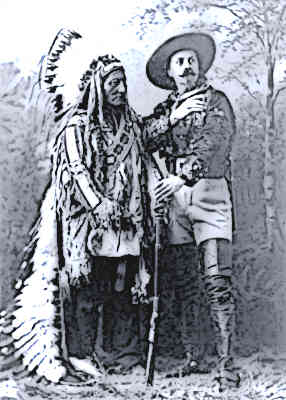American Indian Warrior Sitting Bull
Sitting Bull was a famous Indian leader who belonged to the Native American Sioux tribe. He played a significant part in the Great Sioux War of 1876 during which he became famous as a fierce warrior and a famous leader of the Native Americans.
Early Life of Sitting Bull
Sitting Bull was born in Grand River, South Dakota in 1831. His father was a well-known warrior of the Sioux Tribe called ‘Jumping Bull’. Following the Native American tradition, Sitting Bull trained to be a warrior from an early age.
At a young age, he became an expert at shooting arrows, riding horses and hunting buffaloes. Before he reached the age of 15, Sitting Bull had become known in his tribe as a fearless warrior on the battlefield and had already fought in many battles.

Leading the Lakota Tribe
By the middle of the 19th century, U.S. army and white settlers had started in the homeland of Sitting Bull and his tribe. Sitting Bull initially tried to scare off these new arrivals but that didn’t work.
He then joined forces with the famous Indian warrior Red Cloud and participated in the Red Cloud’s War which began in 1866. During this war, the Native Americans were able to force the U.S. government to let them live in their lands and stop any white settlers from coming there.
But this was a temporary victory and in 1874, gold was discovered in the Black Hills previously owned by the Lakota tribe. Now the U.S. government wanted ownership of the Black Hill which led to another war between the Native Americans and the U.S. government. This was called the Great Sioux War of 1876 and Sitting Bull played an important role in it.
During the Great Sioux War
After gold was discovered in the Black Hills, U.S. government asked the Lakota to give up their ownership of the area. The Lakota refused and went to war with the U.S. government under the leadership of Sitting Bull.
He established a proper war camp of the Native American tribes and was able to attract thousands of Indian warriors. In the war, he inflicted a lot of damage on the U.S. army and won the famous victory at the Battle of Little Bighorn where U.S. army lost more than 250 soldiers.
But the tide of the war soon turned against the Native Americans and the U.S. army defeated Sitting Bull and his warriors in many subsequent battles.
Surrender and Later Life
By 1877, U.S. army had effectively crushed the resistance offered by the Sioux tribes. Many important Native American warriors surrendered to the U.S. army. Sitting Bull refused to do so and crossed the border to live in Canada.
He later returned back to U.S. in 1881 and surrendered. From 1881 to 1890, Sitting Bull peacefully lived at the Indian reservation established by the U.S. government.
In 1890, he was suspected of plans to escape from the reservation, so the government tried to have him restrained. Sitting Bull resisted and in the resulting shoot-out, Sitting Bull was killed.
